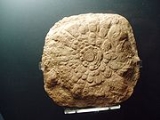
Mawsonites
Encyclopedia
Mawsonites is a kind of fossil
from the Ediacaran
period (630 – 542 million years ago) from the Precambrian
era. The fossils consist of a rounded diamond shape, made up from lobes radiating out from a central circle roughly 12 cm in diameter. There are about 19 radiations from the central circle.
The type species is Mawsonites spriggi, named after Douglas Mawson
, and Reg Sprigg
.
It was named by Martin Glaessner
and Mary Wade in 1966.
Its biological affinities were called into question amidst suggestions that it might represent a mud volcano
or other sedimentary structure, but further research showed that these structures could not satisfactorarily account for its complexity.
Theories about what it is are algae holdfasts, jellyfish, a filter feeder, a burrow, and a microbial colony.
Fossil
Fossils are the preserved remains or traces of animals , plants, and other organisms from the remote past...
from the Ediacaran
Ediacaran
The Ediacaran Period , named after the Ediacara Hills of South Australia, is the last geological period of the Neoproterozoic Era and of the Proterozoic Eon, immediately preceding the Cambrian Period, the first period of the Paleozoic Era and of the Phanerozoic Eon...
period (630 – 542 million years ago) from the Precambrian
Precambrian
The Precambrian is the name which describes the large span of time in Earth's history before the current Phanerozoic Eon, and is a Supereon divided into several eons of the geologic time scale...
era. The fossils consist of a rounded diamond shape, made up from lobes radiating out from a central circle roughly 12 cm in diameter. There are about 19 radiations from the central circle.
The type species is Mawsonites spriggi, named after Douglas Mawson
Douglas Mawson
Sir Douglas Mawson, OBE, FRS, FAA was an Australian geologist, Antarctic explorer and Academic. Along with Roald Amundsen, Robert Falcon Scott, and Ernest Shackleton, Mawson was a key expedition leader during the Heroic Age of Antarctic Exploration.-Early work:He was appointed geologist to an...
, and Reg Sprigg
Reg Sprigg
Reginald Claude Sprigg, AO, HonDSc ANU, HonDSc Flinders, MSc Adelaide, FTSE was an Australian geologist and conservationist. At age 17 he became the youngest Fellow of the Royal Society of South Australia. In 1946, in the Ediacara Hills, South Australia he discovered the Ediacara biota, an...
.
It was named by Martin Glaessner
Martin Glaessner
Martin Fritz Glaessner AM was a geologist and palaeontologist. Born and educated in Austro-Hungarian Empire, he spent the majority of his life in working for oil companies in Russia, and studying the geology of the South Pacific in Australia...
and Mary Wade in 1966.
Its biological affinities were called into question amidst suggestions that it might represent a mud volcano
Mud volcano
The term mud volcano or mud dome are used to refer to formations created by geo-excreted liquids and gases, although there are several different processes which may cause such activity. Hot water mixes with mud and surface deposits. Mud volcanoes are associated with subduction zones and about 700...
or other sedimentary structure, but further research showed that these structures could not satisfactorarily account for its complexity.
Theories about what it is are algae holdfasts, jellyfish, a filter feeder, a burrow, and a microbial colony.

